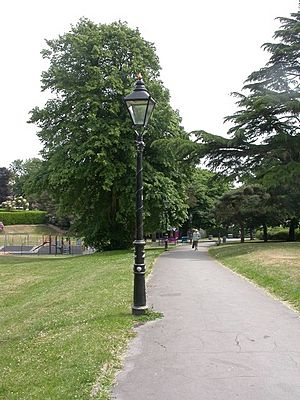Alexandra Park, Poole facts for kids
Quick facts for kids Alexandra Park |
|
|---|---|
 |
|
| Location | Upper Parkstone, Poole |
| Area | 5.4 acres |
| Open | 1906 |
Alexandra Park is a lovely public park in Parkstone, Poole, on the south coast of England. It's about 5.4 acres big, which is like five football fields! This park used to have a bowling green and a special building for the Alexandra Park Lawn Bowls Club, which started in the 1920s.
The park was mostly planned during the Edwardian period (the early 1900s). It took over 30 years to create. This area was once open farmland. It slowly became a new neighbourhood with homes. The park land was chosen because it had hills and dips, making it perfect for fun activities instead of building houses. In 2019, the old bowling building became a café. The children's playground also got a cool makeover with new equipment.
Discovering Alexandra Park's Past
The story of Alexandra Park comes from a document written in 1995. It was put together by Paul Hillman, a local historian. He was also the Landscape Architect for the Poole Borough Council for many years.
How the Park Began (1831–1905)
Most of the land for Alexandra Park was part of the "Upper Parkstone Estate." This large area was given to the local council in 1831. The first sign that this specific piece of land would be a public park was in 1885. The council asked local architects to draw plans for the Upper Parkstone Estate.
Three plans were sent in:
- Au bon droit (meaning "with good right")
- Quod petis hic est ("whatever you seek is here")
- Spero ("hope")
The "Spero" plan was chosen. Its architect won £25. Today, you can see "Spero 2006" carved on the entrance pillars. These pillars were put up in 2009 to celebrate the park's 100th birthday. The other two architects received £7 7s.
The original plans are now lost. But a lease from 1885 was found. It was for land next to the park. This lease said no buildings could be built on that area. Not much else was found until 1901. By then, the area was clearly marked as open space on a development map. The park probably developed slowly because there weren't many homes nearby yet. People needed to move in before a park was truly needed.
In 1903, council notes mentioned plans for "Pleasure Grounds in Upper Parkstone." We don't know what these plans were. But around that time, paths were built. Railings, gates, and a noticeboard were also added along what is now Alexandra Road.
The Park Takes Shape (1906 - 1930)
On June 28, 1906, the council decided to name the pleasure grounds "Alexandra Park." It's believed the park was named after Alexandra of Denmark. She was the Queen, wife of King Edward VII, who ruled at the time. This is also why Queen's Park, Bournemouth was named in 1902.
After the park was named, more attention was given to making it better. In 1907, steps were taken to stop nearby landowners from making shortcuts into the park through their gardens. Also in 1907, the council started trying to get an entrance from Palmerston Road. This issue took five years to sort out.
In September 1912, a man named Mr. John Joseph Norton offered a 20-foot wide path for £63. This path was called Plot 63. The deal included a rule that vehicles couldn't use this entrance. The council agreed. Mr. Norton was a kind businessman. He likely helped the council rather than trying to make a profit. Other offers for access were much more expensive.
Meanwhile, in 1909, the Borough Surveyor was asked to plan how to lay out Alexandra Park. They wanted to apply for a loan to do the work. It's not clear why these plans didn't happen. Maybe the loan was not approved because access to the park was still difficult.
Finally, on January 23, 1913, the Borough Surveyor showed a new plan for the park. It would cost £1,200. The Parks Committee asked for a cheaper plan, costing £600. They applied for a loan for this amount. This time, the application was successful! A loan of £600 was approved on February 20, 1913.
Different companies were hired to do the work:
- February 1913: Mr. G. T. Budden installed a drain for surface water. This cost £54 15s.
- June 1913: Burt & Vick supplied seven park benches for £18.
- June 1913: Mr. W. H. Seller supplied and installed railings.
Trees and shrubs were bought from Mr. C. Stewart (now Stewarts Garden Centres) for £50.
So, Alexandra Park is mostly an Edwardian park that grew over time. This growth continued:
- July 1914: All the footpaths were upgraded to tarmac.
- November 1914: A 'memorial' (like a petition today) was read to the Parks Committee. It asked the council to create a bowling green and start a Bowling Club.
The councillors agreed to build a bowling green. But then World War I (1914-1918) happened. So, no progress was made until 1923. On March 22, 1923, plans were made for a bowling green. It would cost £1,200. A small pavilion (a small building) would cost an extra £130. These plans were part of a bigger project. This project also included creating a bowling green, pavilion, and tennis courts at Branksome Park.
A loan for both projects, totaling £3,351, was approved on June 19, 1923. The first pavilion was built in the southwest corner of the bowling green. In 1931, an open shelter was added next to it.

